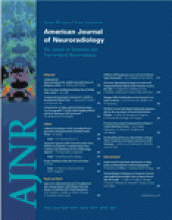Abstract
BACKGROUND AND PURPOSE: Cerebral vasospasm remains a major problem in patients recovering after surgical treatment of cerebral aneurysms. The purpose of this study was to evaluate cerebral vasospasm at multidetector-row spiral CT angiography (MDCTA) compared with digital subtraction angiography (DSA) in patients with aneurysmal subarachnoid hemorrhages (SAHs).
METHODS: Seventeen patients suspected of having vasospasm on clinical findings underwent both postoperative MDCTA and DSA. MDCTA was analyzed by using volume-rendered images as well as axial images. A total of 251 arterial segments were analyzed for vasospasm by using a 5-point grading system. The MDCTA results were then compared with findings on the corresponding DSA images. Sensitivity, specificity, and accuracy of MDCTA for detection of hemodynamically significant spasms were also calculated, with findings at DSA used as the reference standard.
RESULTS: On DSA, 74 spasmatic segments were found among the 251 segments evaluated, and 40 segments with hemodynamically significant vasospasms were present. The overall agreement between MDCTA and DSA was 95.2%. We had 12 (4.8%) cases of disagreement between MDCTA and DSA. In 11 segments, the degree of stenosis was overestimated at MDCTA. Overall accuracy, sensitivity and specificity of MDCTA in the detection of hemodynamically significant vasospasm were 97.5%, 98.1%, and 98.0%, respectively, with positive and negative predictive values of 90.7% and 99.5%.
CONCLUSION: MDCTA appears to be a reliable alternative imaging technique to DSA in the assessment of patients with cerebral vasospasm after aneurysmal SAH.
- Copyright © American Society of Neuroradiology












